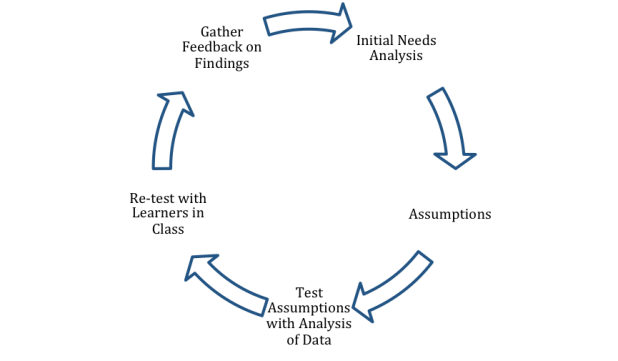Needs analysis is the foundation for providing effective Business English training and it seems more and more often that I am teaching English for meetings. Every school has its own needs analysis questionnaire including a variety of business skills and personalised questions in addition to a language test which give a sense of the ability and preferences of course participants. The results of this needs analysis goes into the syllabus design and informs trainers on what kinds of skills to include in their training. This process, it is safe to say, has taken place as the scientific cornerstone of much our needs analysis practice.
This takes me back to my secondary-school science classes and needs analysis doesn’t differ that much from a scientific experiment in the sense that trainers gather a batch of information that then forms the basis of a number of assumptions. For example, a group of team leaders in an international E-commerce business will need English for a variety of different meetings. What’s the next step? Go and make a syllabus, find materials and input that expose learners to the language they will need for meetings.
Now looking back on my science classes I remember the next essential part of the process was testing these assumptions. To borrow from the start-up culture here in Berlin, assumptions on user and customer behaviour for a new product or service is are numerous and a start-up is the business equivalent of the science class. You wouldn’t find a successful start-up around that hasn’t thoroughly tested its assumptions before launching its product. I had a meeting with a guy from Microsoft earlier this year who was trying to launch an online news app for teachers that reduced their lesson planning time. His assumption was that teachers would buy into the product. Actually, what I believe his conclusion from his initial meetings was that in fact the learners would be the ones buying into the product – trainers already know which articles they like to use and wouldn’t spend money on a product that did that for them.
Anyway, I digress. A needs analysis in my mind is not successful unless it tests the assumptions it provides a trainer. Just today, I was listening to a meeting participants in a course of mine had made of their work meetings and it turns out that yes, they do need language for meetings. My initial observation from the needs analysis was that they needed language for giving updates. What the recordings have however shed light on is that in these meetings the language that causes problems involves two elements: firstly, language to manage the discourse and presenting problems as solutions with longer conditional style phrases like “if we were to have the training on a fixed date every month, would that chance anything” instead of “the problem is that the date keeps changing”.
The more scientific approach I have taken from this is that needs analysis involves:
Without going deeper into the problem, there is the risk that despite an initial needs analysis, the assumptions made may well be far flung from the linguistic needs of participants and the training not as effective at helping them perform better in their jobs.


Hello all,
I am a master’s student in ELT department and I am working on Needs Analysis of medical students. If you have some documents and/or journal articles about this topic please let me know.
Regards,
Cihad.
Hi Cihad,
Thanks for stopping by and taking a look at the blog. In answer to your question, I found this post particularly helpful with needs analysis http://businessenglishideas.blogspot.de/search/label/needs%20analysis
Best of luck for your research!
Dale
Thank you for the link and your wish Dale,
Regards,
Cihad.
All absolutely agreed. The lesson I would take from that is to only plan the first three lessons in detail, with anything after that sketched in with many question marks.
… something that is difficult to disagree with in theory but often doesn’t happen in practice. They taught us precisely that on my LCCI Teaching English for Business course, then the final task asked us to design a two-week course for a student we’d never met… And unfortunately in reality the demands from schools and (especially) clients is more likely to be like the latter situation.
I am so glad I found this post: a great reminder that (any?) needs analysis is an on-going process rather than just something to be done at the beginning of a course. I am now working on developing curriculum for a context I am less familiar with and realize that this learning about a customer (and students or teachers) is a never-ending reflective journey. Thank you for the post once again!